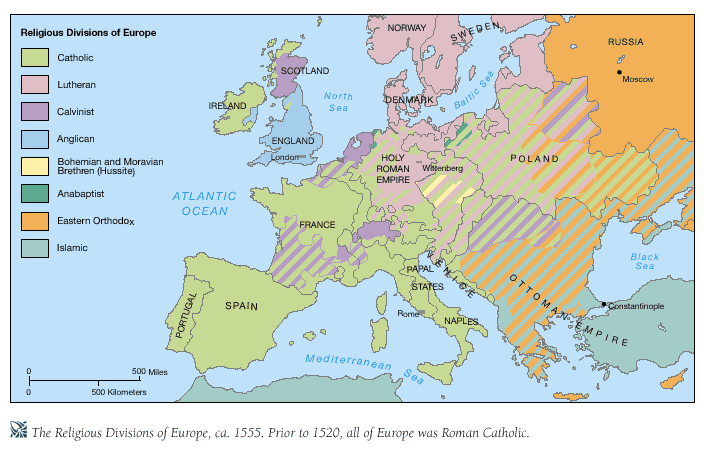Widespread monogamy’s implementation into society first occurred in Germany during the fifteenth century and was catalyzed by the Italian Renaissance, as a practice whose popularity took hold as a type of cultural safeguard, such as the also popular persecution of witches during the Protestant Reformation. This reterritorialization of “taboo” behaviors, especially the sexuality of women, was encoded after the deterritorialization of the world as common society had known it before the growth of globalization, discovery of the New World, and the age of global conquest.
(Image 1)

This map does a good job of showing the mixing of religious divisions as increased globalization dissolved previous notions of the geometric limitations of Europe as well as the rest of the planet. Especially for more heavily Lutheran areas, such as Germany, the ideals present in early processes of cultural containment and preservation, began a habituation of valuing processes that arguably remained as a tradition in German society that carried into the World Wars and beyond.
As stated by Thelewit, “It is rarely economic factors that are operative in the restructuring of the relation between the sexes. What is, however, often very directly operative is an attempt to secure relations of domination that not only impinge directly on, but could be said to realize themselves in, that relation.” (Thelewit 311)
This brings to question the philosophical and anthropological processes of global thought that then promoted the change in society that has then dominated most of western cultural roles of sexuality, the bodies of women and men, and much more, but with the concept of time as a resource as it relates to concepts of common containment and discipline. Because of this abundance of “life” promoted by the monogamous marriage, there can only be an equal and opposite definition created of the death inherent in concepts of marriage, especially monogamous marriages.
(Image 2)

Lovebirds in Germany in the 1500’s, confirming the immortality of their purity. How happy they seem!
As described in Marx’s Nationalokonomie und Philosophie, Luther, as he rejected human and mortal Pope in order to hold accountable “The God within”, a concept named by Klaus Thelewit in Male Fantasies, a book centering on German cultural anxieties and their production of death, that being fascism. Marx described this as how Luther “transplants the priest into the human heart” (Marx 279), as what is initially known as the God of heaven gradually dies, leaving an “inner” God or “conscience”. Klaus Thelewit claims that “This God has become wholly masculine; all the feminine components … have been removed.” (Thelewit 309) This relocates the God as within the male human, yet without the material consequence of mortality.
Once the power to enact a kind of immortality is deterritorialized from the body and relocated in the “conscience”, the need for interpretation of the world and enacting of proper disciplines to keep it contained is heightened. In a world which was being radically reconceptualized in terms of borders and security, some topics that are also being quickly brought to the surface in today’s society due to technological advancement and shifting power dynamics, the looseness and chaos of life seemed imminent. Settling in one city that does not change its values quickly, separating oneself mentally from one’s own bodily inconveniences such as smell and mess, and locating and containing women and masses of people seemed like surefire solutions to the new consequences of the Enlightenment; the shared knowledge that man can make better men if he chooses to.
As Thelewit describes the German bourgeoisie, “The new scion… had to be able to look beyond the surface of things, to plan ahead. He had to be able to distance himself from objects, other humans, and his emotions… In short, he had to perceive himself as a citizen and a man. A human being of that description … had to be ‘modeled’ (Elias’ term for the process). And more and more, the modelers were the parents in what was evolving into a nuclear family”. (Thelewit 311)
Sources:
Elias, Prozess der Zivilization, vol. 1, 260 p.312-341
Foucault, Michel. Discipline and Punish. New York: Vintage, n.d. Print.
Image 1: “Reformation+globalization+map – Google Search.” Reformation+globalization+map – Google Search. N.p., n.d. Web. 14 Feb. 2017
Image 2: Portrait of Jakob Fugger and Sybille Artzt, c. 1500, Unknown Artist, Augsburg
Recent Comments